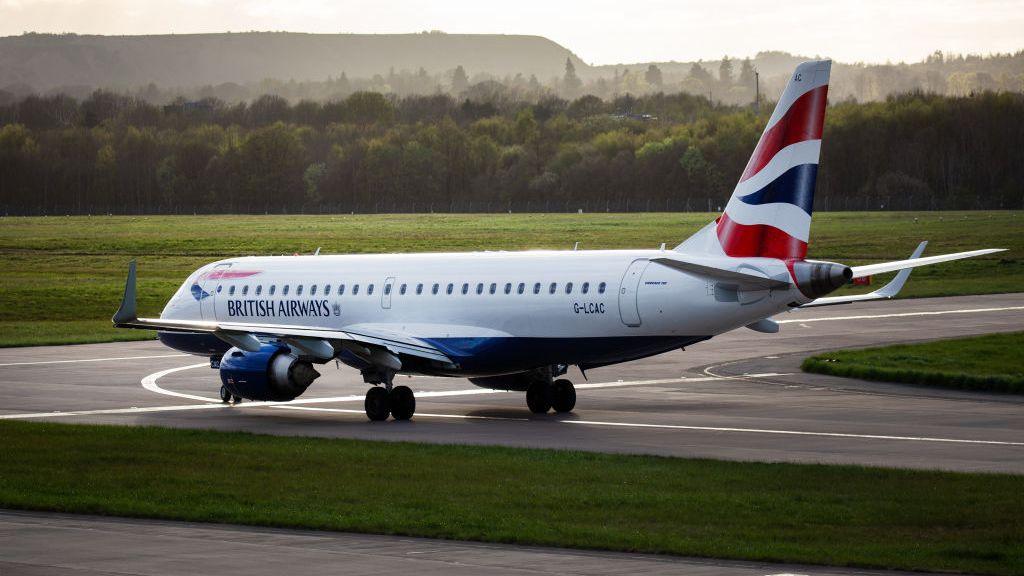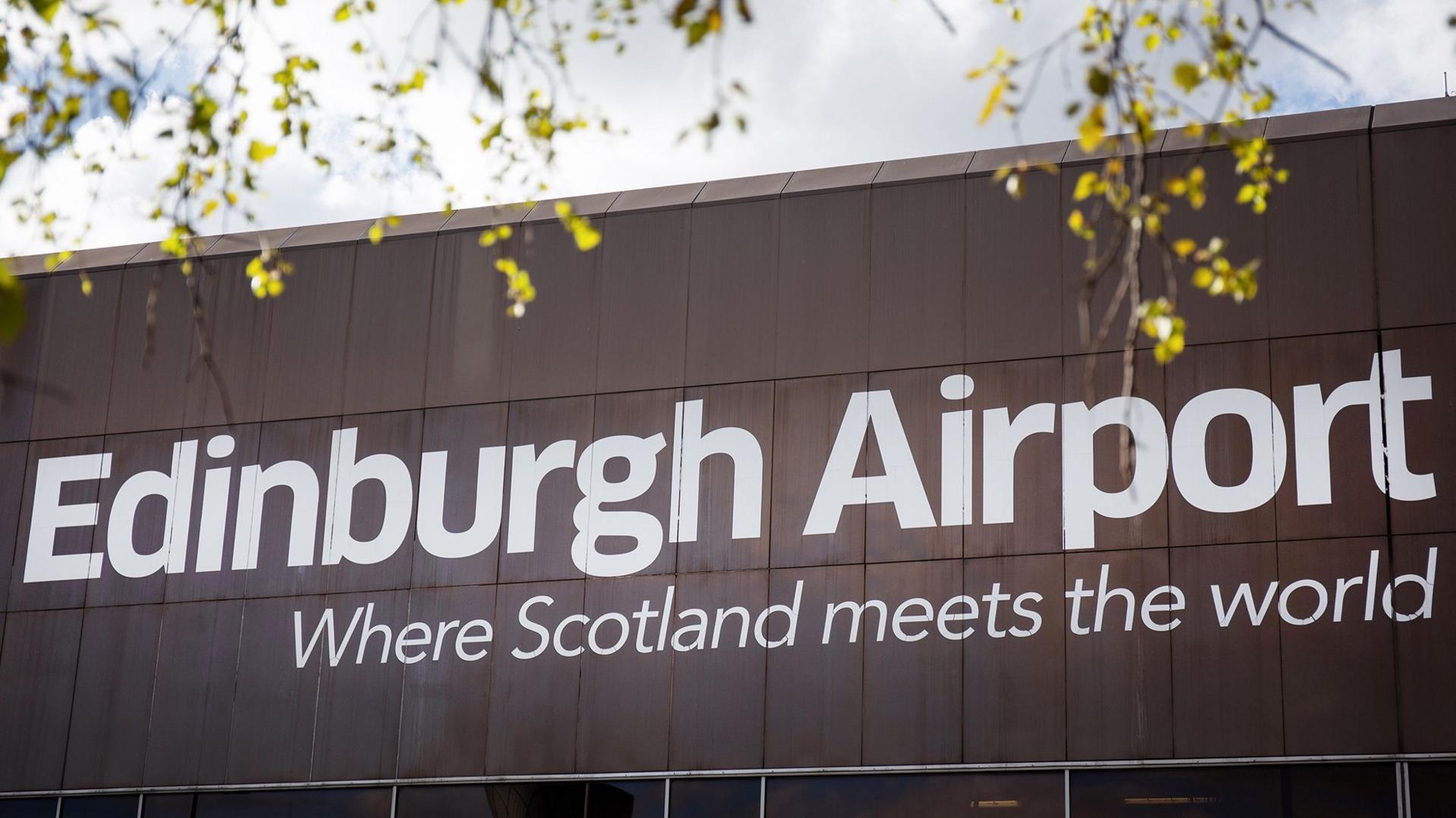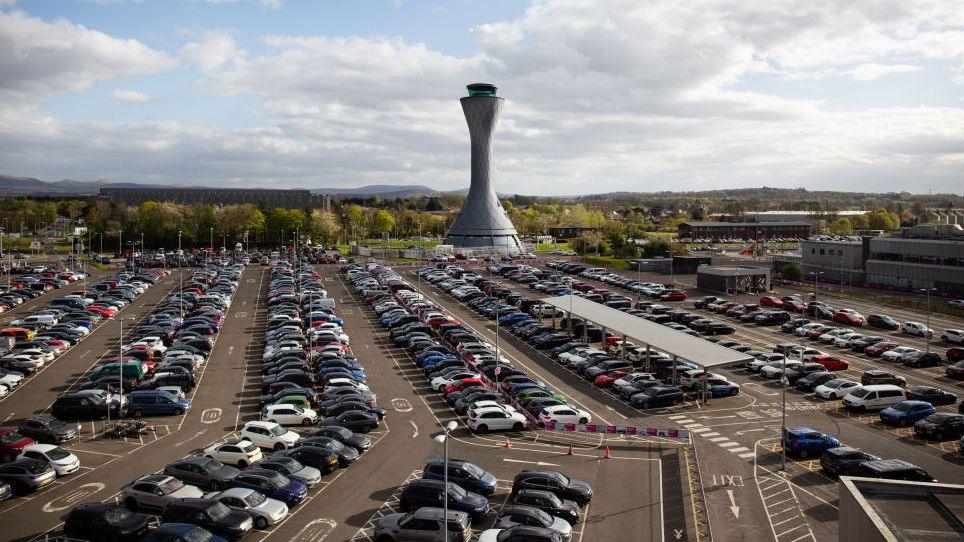Edinburgh Airport hopes for take-off with new owner

Passenger numbers have recovered to almost pre-Covid levels at Edinburgh
- Published
Edinburgh Airport is taking off on a new route as it comes under the control of a French company that claims to be the largest private airport operator in the world.
The new owner, Vinci, is backing an airport business that has bounced back strongly from the pandemic, expecting to hit record passenger numbers this year, and growing by another third within the next six years.
Vinci, which is based in Paris, owns 70 airports around the world, including London Gatwick and Belfast International - and it has now confirmed the transfer of a 50.1% stake in Scotland's busiest airport for £1.27bn.
That means Edinburgh Airport's value has more than tripled in the 12 years since the continuing co-owner, GIP or Global Infrastructure Partners, bought it for what seemed an eye-popping £807m.
That was the amount paid to BAA, which inherited Edinburgh, Glasgow and Aberdeen airports from its nationalised predecessor, the British Airports Authority, along with Heathrow and Gatwick in London.
These airports have since become highly valued sources of profit for huge investment funds, and compete for business where previously BAA put the brakes on competition and growth.

For the investors behind GIP, for whom their stake in Edinburgh Airport was time-limited, the tripling in valuation is not clear profit.
Edinburgh Airport has invested heavily through those years to expand, as regular users know from the many construction works during these years. And the work goes on.
The £1.27bn figure for half the airport means a total valuation of £2.5bn, a remarkable achievement only four years after pandemic struck aviation harder than any other sector.
The airline body IATA calculated that worldwide losses in 2020 totalled nearly $138bn (£109bn at the current exchange rate).
The bounceback has been extraordinary.
The Civil Aviation Authority says UK airport passenger numbers dropped from 300 million in 2019 to 65 million two years later.
Two years further on, in 2023, passengers passing through terminals were up again to 276 million.
UK aircraft movements dropped from 2.3 million in 2019 to 800,000. They have come back to 2 million.
The load factor - a vital measure for the industry, measuring the proportion of seats filled - dropped from 84% to 57%, and rose to 82% last year.
Edinburgh Airport's passenger numbers were up 28% last year to 14.4 million, and it expects to pass its previous peak during this year.
Edinburgh has by far the most passengers in Scotland

Teesside and Heathrow were the only large UK airports to grow faster.
Edinburgh is close to passing Heathrow as the busiest airport for domestic UK passengers, at 4.3 million last year to the London hub's 4.6 million (though only one in 17 of its passengers are on domestic UK routes).
And despite the tensions with the drive to reduce fossil fuel use, the expansion goes on.
By 2030, Edinburgh's management is planning for annual passenger numbers to grow to 20 million.
That is growth by a third, about equal to Scotland’s entire five million population.
That endless development of facilities is not without growing pains.
Staffing for peak periods has been a struggle in a tight labour market coming out of the pandemic, leading to long waits to get through security. There have been industrial disputes and a big luggage backlog.
The falling share of business air travel has also led to longer delays. That used to account for half of passengers.
Leisure travel now makes up two-thirds of those going through security, and holiday travellers take longer to conform with the rules.
They spend lots in the airport terminal, however, which is why critics of airport expansion point to passenger terminals as being more interested in operating shopping malls, restaurants and bars.

The airport is taking steps to try to reduce the numbers of passengers reliant on cars
Further expansion will put more pressure on ground transport, which already produces 16% of the airport's total carbon footprint.
Public transport to and from the airport is used by only 37% of air passengers, lower than the five main airports around London, while 40% use cars and 9% use taxis.
Car park pricing and the "kiss and fly" drop-off charge is not only to make a lot of money for the airport, but is intended to encourage public transport use.
The intention for 2028 is to reach 7.3 million passenger journeys on public transport to and from the airport, while taking 2.8 million car journeys off roads around the Ingliston site.
The airport is offering to build a new link road and cycle route, connecting with the city's Gogar roundabout, and then to hand it over to the city council.
But it has hit planning delays, as so much of the airport's growth clashes with city and national targets for reduced greenhouse gas emissions.
The airport sector has responded to that threat by investing in low-carbon activities in its ground operations, and there are plans to invest in new fuel capacity.
As the area is a focus of activity for housing expansion in Edinburgh's hot property market, airport managers are looking at the potential of a district heating project, serving more than 10,000 nearby homes.
There is a large solar farm alongside Edinburgh’s runway, while the sector looks to engine manufacturers as well as airlines to develop SAF - sustainable aircraft fuel made from crops, cooking oil and synthetic chemicals - to commercial viability and the necessary scale worldwide.
£2bn town planned near Edinburgh Airport
- Published11 January 2024
Airport to build solar farm next to runway
- Published24 June 2021
That is the only way aviation can hope to conform with net zero targets. New co-owner Vinci aims to hit net zero later than most others, in 2050.
The growth of Edinburgh does not go unnoticed towards the other end of the M8 motorway.
Glasgow Airport has also bounced back from the pandemic, but has little more than half of Edinburgh's passenger numbers, and growth was much slower last year, at 13%.
Glasgow retains the lucrative Emirates link with Dubai, but in a tough competition to attract long-haul airlines as they return to Scotland post-pandemic, Edinburgh has secured links with Hainan in China, Istanbul, Qatar, two airlines linking with Toronto, and six scheduled US destinations last year to Glasgow's seasonal one.
One of Edinburgh's advantages is as a city brand that is instantly recognised in overseas marketing.
It also benefits from being close to the centre of the central belt, on a ground transport network that is more accessible to more of Scotland than Glasgow's airport.
And Glaswegians have noticed. The number of bookings to park at Edinburgh Airport made by people with Glasgow postcodes has more than tripled since 2019, and a fifth of such bookers now come from beyond Harthill in west central Scotland.